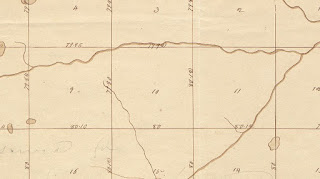 |
| A view south down Union Road from the site of Webbville in Jackson County, Florida. |
Note: This is Part One of a two part series. Click here to continue to Part Two.
Not a soul lives on the site today, but its stories remain some of the most interesting in the county's history.
Florida had been a U.S. territory for only two years when James Webb arrived from Georgia in 1823. A veteran of the War of 1812 and a former school teacher, he had practiced law in both Virginia and Georgia before coming to the "Chipola Settlement" at the age of 31.
Jackson County was only one year old and then stretched from the Choctawhatchee River on the West to the Suwannee River on the east. It included all or parts of today's Holmes, Washington, Bay, Calhoun, Gulf, Franklin, Liberty, Gadsden, Leon, Wakulla, Jefferson, Taylor, Madison, Dixie, Suwannee, Lafayette and Hamilton Counties.
 |
| Not a building remains on the site of Jackson County's first incorporated town. The one-time county seat of Webbville has vanished without a trace. |
One of the earliest American communities in this region was the old Chipola Settlement, which lay south of today's Waddell's Mill Pond and west of the Chipola River. Similar settlements were growing elsewhere within the present Jackson County limits at Campbellton, Greenwood, Irwin's Mill Creek and on the Apalachicola River near Sneads.
James Webb was a family man and it seems strange today that he would pull up stages and head off into a largely unexplored wilderness but this was how fortunes were made on the American frontier of the early 19th century.
His wife, the former Rachel Elizabeth Lamar, was expecting a child at the time and remained back in Georgia with her family and the couple's 10-year-old daughter, Mary Elizabeth, while James headed south to Florida. He would clear land and build a home before they traveled down to join him.
 |
| James Webb's land was located in the Southeast 1/4 of Section 9 and the Southwest 1/4 of Section 10, as shown on this 1826 survey plat. The creek running east to west is Russ Mill Creek. |
Rachel, Mary and the new baby boy, Thomas Francis Webb, arrived in Florida in 1824. The family grew by another member one year later when another baby boy, James William Webb, was born.
Sugar production then rivaled cotton on the plantations of Jackson County and was especially popular along the wetlands and creeks of the Chipola Settlement. James Webb grew sugar cane on his farm, probably sending the stalks down the creek to the sugar mill near the Natural Bridge of the Chipola River at Florida Caverns State Park. Little is known of this early refinery, but the Pensacola newspaper regularly reported the arrival of hogsheads of sugar from the Chipola River region.
Jackson County grew dramatically between 1822 and 1825. The population soared from fewer than 200 to more than 2,000 in that short time period. The Chipola Settlement emerged as the largest community within today's county limits and a central village began to grow on Section 16, Township 5 North, Range 11 West.
 |
| Union Road crosses Russ Mill Creek by way of a wooden bridge. The creek was an important source of water power for grist and saw mills that served Webbville. |
The growth of the community further spurred by an act of the Florida Territorial Legislative Council on January 20, 1827. Hoping to head off a growing dispute over the permanent location of a county seat for Jackson County, the legislators appointed a commission to select the final site, survey the community and initiate the sale of lots. James Webb was one of the five members named to this board.
While the selection committee did its work, the legislative council decreed that the courts of Jackson County would meet on Section 16, Township 5 North, Range 11 West. This was the location of Stone's Store, Webb's law office and the growing community of business and houses that would become the county's first town.
Stone's Store had been named a U.S. Post Office the previous June and on February 2, 1837, ads appeared in the Pensacola Gazette announcing that the village had been named Webbville.
 |
| Jackson County's first post office, first hotel and first public school stood atop this hill at Webbville. |
The first quarterly examination of the students of this institution took place this day, under the direction of the Trustees, and they take much pleasure in stating, to parents and guardians who have placed their children and wards in this Seminary, that the examination was highly satisfactory and reflected much credit on the teacher, for his care and abilities in conducting the school, and upon the pupils, for their industry and attainments. - Trustees of Webbville Academy to the Pensacola Gazette, May 27, 1827, published in the Pensacola Gazette, June 22, 1827.
James Webb signed the report as one of the school's seven Trustees. The others were Peter W. Gautier, Thomas Baltzell, William P. Hort, Joseph Russ, William J. Watson and Thomas Russ.
Webbville hosted a 4th of July celebration that year. A "numerous assemblage of citizens" listened as Benjamin W. Cumming read the Declaration of Independence. A speech and dinner followed, but the evening's toasts - accompanied by gunfire - were the highlights of the day.
Independence Day of 1827 found Webbville on the verge of great success. Its population and business community were growing. It had been temporarily designated as county seat and the county's first school was functioning well.
The prosperity would not last. A major political fight loomed on the horizon, as did a change that would start James Webb down the path to a remarkable life.
Please click here to continue to Part 2 of this two part series.









